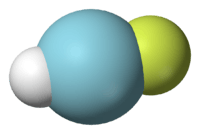Argon fluorohydride
 | |
| Names | |
|---|---|
| Other names
Argon hydrofluoride | |
| Identifiers | |
| 163731-16-6 | |
| 3D model (Jmol) | Interactive image |
| ChemSpider | 15863741 |
| |
| |
| Properties | |
| HArF | |
| Molar mass | 59.954 g/mol |
| Appearance | Unknown |
| Density | Unknown |
| Melting point | −256 °C (−428.8 °F; 17.1 K) (decomposes) |
| Unknown | |
| Except where otherwise noted, data are given for materials in their standard state (at 25 °C [77 °F], 100 kPa). | |
| | |
| Infobox references | |
Argon fluorohydride (systematically named fluoridohydridoargon) or argon hydrofluoride is an inorganic compound with the chemical formula HArF (also written ArHF). It is a compound of the chemical element argon.
Discovery
The discovery of this first argon compound is credited to a group of Finnish scientists, led by Markku Räsänen.[1] On 24 August 2000, in the journal Nature, they announced their discovery of argon fluorohydride.[2]
Synthesis
This chemical was synthesized by mixing argon and hydrogen fluoride on a caesium iodide surface at 8 K (−265 °C), and exposing the mixture to ultraviolet radiation. This caused the gases to combine.
The infrared spectrum of the resulting gas mixture shows that it definitely contains chemical bonds, albeit very weak ones; thus, it is argon fluorohydride, and not a supermolecule or a mixture of argon and hydrogen fluoride. Its chemical bonds are stable only if the substance is kept at temperatures below 17 K (−256 °C); upon warming, it decomposes into argon and hydrogen fluoride.
References
- ↑ Räsänen, Markku (17 December 2013). "Argon out of thin air". Nature Chemistry. 6 (1): 82. doi:10.1038/nchem.1825.
- ↑ Khriachtchev, Leonid; Mika Pettersson; Nino Runeberg; Jan Lundell; Markku Räsänen (24 August 2000). "A stable argon compound". Nature. 406 (6798): 874–876. doi:10.1038/35022551. PMID 10972285.
Further reading
- Emsley, John (2001). Nature's Building Blocks: An A–Z Guide to the Elements. Oxford: Oxford University Press. ISBN 0-19-850341-5.